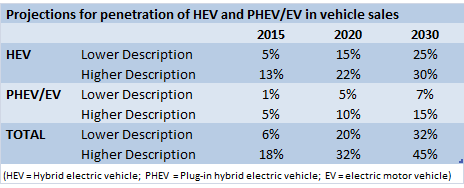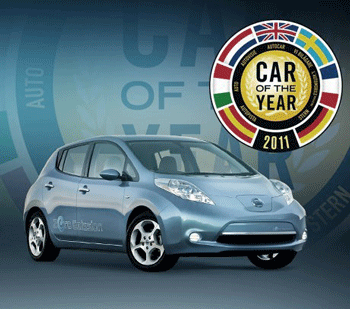Electric cars and hybrids set to impact negatively on Powder Metallurgy (PM) part production
With hybrid electric (HEV), plug-in hybrid electric (PHEV), and all electric vehicles (EV) set to claim 20% of automotive sales within the next decade, Hitachi Powder Metallurgy Co Ltd (www.hitachi-chem.co.jp), the Powder Metallurgy (PM) division of Hitachi Chemicals in Japan, has undertaken a timely review of the estimated impact that the move to HEV, PHEV and EV cars will have on the future demand for structural PM parts.
The review, compiled by Toru Nakata and published in the Hitachi Chemical Technical Report (No.9, 2010), is based on an analyses of published data from automotive forecaster CSM Worldwide plus present applications for PM parts and PM bearings in various parts of automobiles, and specifically in engines, fuel systems and drive train, in the various regions around the world. Kanata also includes his own estimates on the growing popularity and market penetration of HEV, PHEV, and EV mainly as a result of environmental pressures on automotive producers to meet emissions targets, especially the reduction of nitrogen-oxide emissions from diesel engines.
The continuing increases in petrol and diesel prices will also have an impact, stated Nakata. He projects that the combined penetration of HEV, PHEV, and EV vehicles could reach 15% of vehicle sales by 2015, 30% by 2020, and 45% by 2030.
In the case of HEV and PHEV the exact impact on the PM structural part market is difficult to ascertain because the smaller internal combustion (IC) engines used will still continue to use PM parts, although the parts will be smaller and some mechanical parts will be replaced by increasing use of electronics.
On the plus side there is some potential for PM iron soft magnetic parts in the new electric motors used in the HEV and PHEV. In the case of the fully electric vehicle, there will be no IC engine, drive train or fuel system as in the hybrid and hence no PM parts. As a result the demand for PM parts in EV cars will shrink to 23.3% of that of conventional cars with IC engines.
As with HEVs there is potential for PM soft magnetic parts to be used in the electric motor. The impact on the loss of the use of PM bearings in EV cars is said to be less severe with applications shrinking by an estimated 20.7%.
Nakata stated that if the market penetration of HEV, PHEV, and EV automobiles proves correct then the estimated impact on the overall demand for PM parts in vehicles could see production fall by up to 3.9% by 2015, by 7.7% by 2020, and by 11.6% by 2030.
Nissan’s Leaf ‘European Car-of-the-Year 2011’ set to boost electric vehicle sales
A host of automotive producers, including Ford and General Motors in North America, BMW, Daimler, PSA Peugeot Citroen and Nissan/Renault in Europe and Nissan, Honda, Toyota and Mazda in Japan, are developing new all electric (EV) and hybrid electric vehicles (HEV) to meet the tighter environmental regulations which are due to come into effect over the coming years.
The regulations include the requirement for carmakers to cut nitrogen-oxide emissions for diesel engines by 56%.
Few diesel cars now comply with the new regulations, such as the Euro 6. According to HIS, the Euro 6 rules may help raise the share of hybrid and electric vehicles across Europe from about 0.1% today to 13% by 2020. Additional incentives to buy electric include government grants and the continuing rise in fuel costs.
All electric cars were given a boost with the announcement at the end of November 2010 that the Nissan ‘Leaf’ had been voted European Car of the Year 2011, the first time that the award has been given to an electric car. The Leaf is powered by a front-mounted compact electric motor, which drives the front wheels. The car has a range of more than 160km (about 100 miles).
According to Automotive News Europe, the Nissan Leaf beat 40 contenders including runner-up the Alfa Romeo Giulietta and third-place-finisher the Opel/Vauxhall Meriva to win the award, which is chosen by 57 motoring journalists from 23 European countries.
Carlos Ghosn CEO of Nissan said the award shows that the Leaf is competitive to conventional cars in terms of safety, performance, spaciousness and handling. “With three other electric vehicles in the pipeline from Nissan and with the imminent market introduction of four additional electric vehicles from our alliance partner Renault, the Leaf represents a significant first step toward a zero-emission future,” said Ghosn. The Leaf will go on sale in Japan and the United States starting in December 2010, and in selected markets in Europe early in 2011.
Nissan plans to create annual capacity to build 250,000 Leafs a year with 150,000 units planned at its U.S. plant in Smyrna, Tennessee, and 50,000 each at factories in Sunderland, England, and Oppama, Japan.
Will the grid cope with plug-in EVs?
A further report in Automotive News Europe (November 30, 2010) states that electric cars will make up 20% of U.K. auto sales by 2016 and that 1 million EV cars will be on UK roads by 2020 as drivers take advantage of government subsidies and lower fuel costs. According to Steve Holliday, who runs the UK’s National Grid for electricity, motorists will receive as much as £5,000 pounds ($7,795) from January 2011 if they buy an EV or PHEV car. He stated that the national recharging network for EVs with around 300 roadside plug-in points at the present will be boosted to 11,000 plug-in points by 2013. EV cars can also be recharged at home or at work.
While National Grid’s high-voltage electricity transmission system can manage the demand of 1 million electric cars, “penetration up and above that becomes a real issue,” Holliday said. Local distribution networks in cities like London may struggle to balance their grids if drivers choose to all plug in their cars at the same time, he said.
The Society of Motor Manufacturers and Traders (SMMT) estimates the cost of charging an electric car such as the Nissan Leaf with its 100- mile range to be just under £1 and take between six and eight hours. Total fuel costs of operating a standard car, driving 10,000 miles annually over a three year period, are around £2,767, compared with £756 pounds for an electric car operated over the same time period, states the SMMT.
News | Articles | Market reviews | Search directory | Subscribe to e-newsletter








